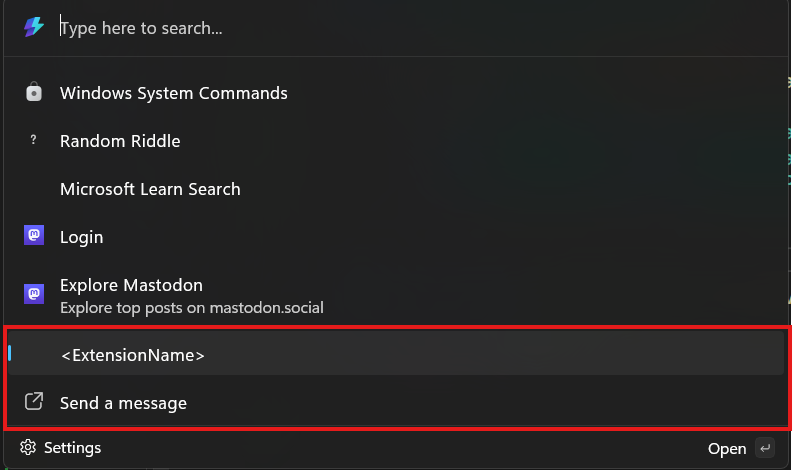Note
Access to this page requires authorization. You can try signing in or changing directories.
Access to this page requires authorization. You can try changing directories.
Previous: Update a list of commands.
So far, you've only added commands to a single page within your extension. You can also add more commands directly to the top-level list of commands too.
Top-level commands
To add commands at the top level of the Command Palette, open the <ExtensionName>CommandsProvider.cs file. This is where you define the commands that will appear at the root level of the Command Palette.
Currently, the file contains only one command:
public <ExtensionName>CommandsProvider()
{
DisplayName = "My sample extension";
Icon = IconHelpers.FromRelativePath("Assets\\StoreLogo.png");
_commands = [
new CommandItem(new <ExtensionName>Page()) { Title = DisplayName },
];
}
public override ICommandItem[] TopLevelCommands()
{
return _commands;
}
When the extension is created, it builds a list of commands and stores them in the _commands field. Every time the extension is asked for its top-level commands, it simply returns this prebuilt list. This approach avoids recreating the command list on each request, which improves performance.
Add another top level command
- In Visual Studio, open
<ExtensionName>CommandsProvider.cs - Add another
CommandItem:
public <ExtensionName>CommandsProvider()
{
DisplayName = "My sample extension";
Icon = IconHelpers.FromRelativePath("Assets\\StoreLogo.png");
_commands = [
new CommandItem(new <ExtensionName>Page()) { Title = DisplayName },
+ new CommandItem(new ShowMessageCommand()) { Title = "Send a message" },
];
}
Note
The ShowMessageCommand() functionality was created prior at InvokableCommand Command
- Deploy your extension
- In Command Palette,
Reload

Now there is an additional top-level commands to your extension.
Add top level command dynamically
If you'd like to update the list of top-level commands dynamically, you can do so in the same way as you would update a list page. This can be useful for cases like an extension that might first require the user to log in, before showing certain commands. In that case, you can show the "log in" command at the top level initially. Then, once the user logs in successfully, you can update the list of top-level commands to include the commands that required authentication.
Once you've determined that you need to change the top level list, call RaiseItemsChanged on your CommandProvider. Command Palette will then request the top-level commands via TopLevelCommands again, and you can return the updated list.
Tip
Create the CommandItem objects for the top-level commands before calling RaiseItemsChanged. This will ensure that the new commands are available when Command Palette requests the top-level commands. This will ensure that the work being executed in each call to TopLevelCommands method to a minimum.
Next up: Command Results
Related content
Windows developer
